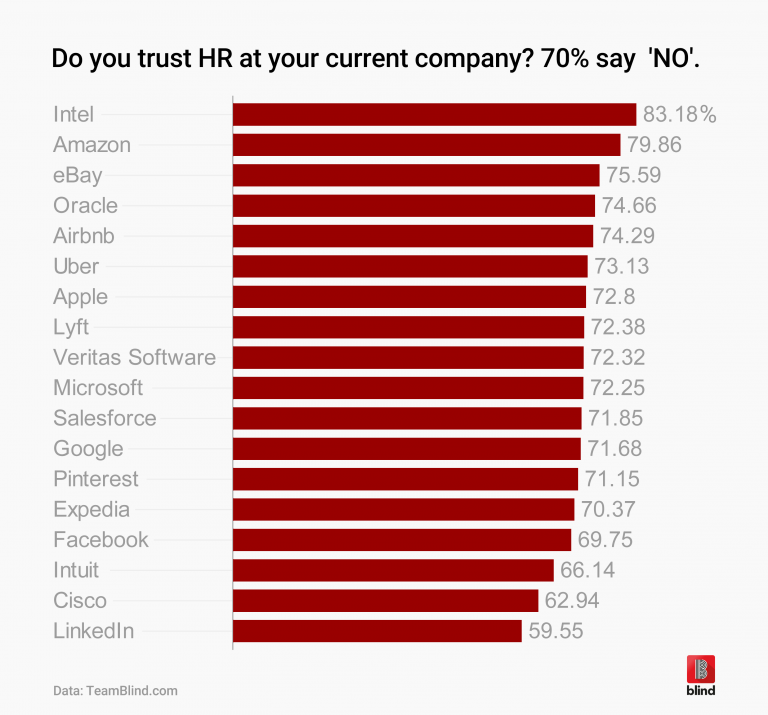Editor’s Note: It’s an annual tradition for TLNT to count down the most popular posts of the previous 12 months. We’re reposting each of the top 30 articles through January 2nd. This is No. 14 of the 800 articles posted in 2018. You can find the complete list here.
∼∼∼∼
Building employee trust is a cornerstone of HR’s values. So, everyone in HR should pay immediate attention when they learn that in excess of 70% of employees working at each of the top 4 most valuable firms in the US report that they “Don’t trust HR.”
the top 4 most valuable firms in the US report that they “Don’t trust HR.”
Yes, a recent survey by TeamBlind found that even at these four powerhouse top market cap firms, the percentage of their employees who don’t trust HR is painfully high:
- Apple 72%
- Amazon 76%
- Google at 72%
- Microsoft 71%
And among 18 surveyed tech firms and over 11,000 responses on Blind, the worst performing firm was Intel with a whopping 82% of its employees not trusting HR. The best performing firm, LinkedIn, still had 59% of its employees not trusting HR. Blind (a workplace sharing community) also reported that among every one of the employees at the surveyed tech companies, a majority didn’t trust HR:
“Over 50 percent of employees from every company say that they don’t trust HR at their current workplace.”
And if one survey is not enough to convince you that HR has a “trust problem,” another recent (in this case a multi-industry) survey — “Perceptions of HR, what employees really think about HR” by BambooH — provided what it labeled as” bad news” that “Employees don’t have trust or confidence in HR.”
No one will take action until they understand the consequences of low trust
Unfortunately, when HR leaders see data revealing that their employees don’t trust them, I find their first reaction is to dismiss the data. However, if a firm has an average distrust rate of over 70%, even if the data was off by half, they would still have a serious problem that is likely costing any major corporation millions of dollars. My recommendation is to start by fully understanding the consequences of a lack of employee trust. They include:
A loss of workforce productivity – Unresolved employee and workplace issues are at the very least a major distraction for both your employees and managers. Whenever a significant percentage of your employees are concerned about discrimination, unfairness or a lack of responsiveness, you can expect a double-digit reduction in workforce productivity. In addition, you can’t expect frustrated or distracted employees to be innovative, creative or forward-looking.
Employee turnover will increase dramatically – Any firm that conducts delayed post-exit interviews will quickly learn that in times of low unemployment, employee frustration is a major cause of top performers leaving. Because when employees feel that their major issues won’t soon be resolved, those with multiple career choices will simply leave. An example of the consequences of low employee trust was cited in the TeamBlind report;an engineering employee reported that, “It is less of a hassle to quit than complain to HR about anything.”
Recruiting top talent will become more difficult – When top potential applicants read employee responses on sites like Glassdoor and Blind that a firm’s employees don’t trust leadership or HR. They will avoid applying for jobs at those firms. And those who do apply will likely drop out once they encounter your frustrated employees during the interview process.
Reduced feedback and communications will hide problems – Two-way communications and honest, direct feedback are essential for identifying and resolving workforce, customer, and product problems. However, when employees view the employee / HR relationship as an “us against them conflict” issues like sexual harassment will fester and develop into more serious ones (e.g., Uber) as employees become more reluctant to provide feedback or to raise concerns. Frustrated employees who lack trust are also much less likely to follow HR advice and even rules.
Action steps for increasing employee trust
Space limitations prevent me from going into detail about how HR can build trust among its employees. However, here’s a quick overview of some of the HR action steps that I have found to be effective in rebuilding employee trust. They are presented with the most impactful actions appearing first.
Make the business case for increasing trust – Work with the CFO’s office to quantify in dollars the negative business consequences that result from reduced employee trust levels. Use those dollar consequences to change executive and management behaviors and to get increased funding for your trust building efforts.
Become data-driven on employee trust – It’s a mistake to use intuition and speculation to decide what factors contribute to a high level of employee trust. Instead, use data to identify the best ways to measure employee trust and to identify the specific factors that contribute to it at your firm. Incidentally, don’t be surprised when you learn that the factors that build trust vary significantly among executives, professionals and hourly employees. It’s important to note that a “trust in HR survey” is completely different from an employee engagement survey. If you conduct your own internal “trust in HR survey,” be aware that your employee’s fear of their responses being found out will likely cause your numerical results on trust levels to be higher than those found in the external TeamBlind survey.
Read the newspaper – You don’t have to be a data scientist to identify the “current issues” that employees at most major firms are talking about. Hot workplace issues are now discussed in all major media. Today, for example, it would make sense to build employee trust by focusing on women’s issues, sexual harassment, diversity, and environmental issues. Also, take the time to monitor internal social media sites and to work with your affinity groups to identify workplace issues that impact trust.
Become more responsive – I have found that employees are almost universally frustrated with what they view as a lack of responsiveness from HR. It’s essential to measure and continually improve the time it takes for HR to respond to employee questions, requests, complaints, and problems. You must also measure the satisfaction with the response to ensure that it meets the expectations of your employees.
Develop effective listening mechanisms — Almost every definition of trust includes the willingness of HR and management to listen to employees. Use data to determine which forums, processes, and mechanisms are viewed by your employees as the best ways for HR and management to become active listeners. That is because a firm can’t have the highest levels of trust unless its employees feel they have the opportunity to openly and freely voice their concerns and that HR will listen and adequately respond to them.
Be more proactive in communications — rather than hiding employee impact issues or waiting for them to explode. Proactively communicate with your employees using multiple approaches to issues that might concern them. Try to eliminate “surprise announcements,” instead, when feasible provide early and continuous information. However, also make it clear to your employees which information areas HR must and will keep secret. Specifically,
Transparency is now a requirement – Assume that most employees and especially younger ones have come to expect and even demand transparency. And that means HR must provide detailed information on its goals, why rules and policies are necessary and precisely how HR processes operate.
Fully explain the role of HR – Some employees mistakenly assume that the role of HR is that of an employee advocate. (It isn’t, that’s the role of a union). Start by explaining the role and the goals of HR during onboarding. Also, make any HR biases towards management and business results clear, as well as identifying any areas where HR strives to act as a neutral party.
Make your business partners “Talent Advisors” – because most employees don’t regularly interact with corporate HR. A great deal of employee trust in HR will come as a result of their interaction with their HR generalist or business partner. If you want that trust to increase, your business partners need to transition into a Talent Advisor role, where they are more forward-looking, proactive, data-driven, results-oriented and less focused on relationships.
Help increase productivity – and finally, turn HR into a productivity improvement center. And that means, rather than focusing exclusively on rules and legal compliance, HR professionals should spend much of their time helping employees and managers be more effective and productive. Productive employees are more likely to be recognized, rewarded and have high job security. And those three additional factors will likely increase trust.
Final thoughts
I would be the first to admit that trust is a mental state that is hard to define. However, it is clear that a lack of employee trust in HR or management does, in fact, have direct and measurable negative business consequences. Executives don’t always see the connection between employee trust and productivity. On the product side, they clearly know the connection between customer trust and future sales. I urge HR leaders to calculate the correlation between high employee trust scores and the productivity, retention and recruiting success levels reached by individual teams. Because, without that connection, I find that most executives and HR leaders almost instantly postpone any discussion covering employee trust levels.
Author’s note: If this article stimulated your thinking and provided you with actionable tips. Please take a minute to follow or connect with Dr. Sullivan on LinkedIn and to subscribe to TLNT Daily
